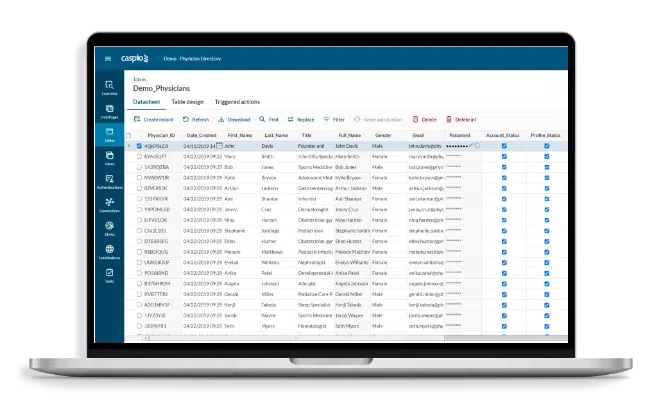No-Code Open Platform Database Creation: Streamline Facility Growth Jobs
No-Code Open Platform Database Creation: Streamline Facility Growth Jobs
Blog Article
A Comprehensive Overview to Executing Scalable Databases Without the Need for Coding Experience
In the contemporary landscape of information management, the ability to execute scalable data sources without coding proficiency is becoming increasingly important for organizations of all sizes. This overview intends to light up the procedure, concentrating on easy to use tools and instinctive interfaces that demystify database configuration. By examining essential features, reliable techniques for application, and ideal methods for ongoing management, we will certainly deal with just how also non-technical individuals can with confidence browse this complicated terrain. What are the vital elements that can truly encourage these customers to take advantage of scalable databases efficiently? The answers might redefine your technique to data monitoring.
Recognizing Scalable Databases
In the world of contemporary information administration, scalable databases have arised as a vital solution for companies seeking to manage increasing quantities of info efficiently. These databases are designed to accommodate development by enabling the seamless addition of sources, whether with straight scaling (including much more equipments) or vertical scaling (updating existing makers) This versatility is necessary in today's hectic digital landscape, where data is created at an unprecedented price.
Scalable databases typically use dispersed designs, which enable data to be spread throughout numerous nodes. This distribution not only improves efficiency but likewise offers redundancy, making certain data availability even in case of hardware failings. Scalability can be a critical element for different applications, consisting of shopping systems, social media networks, and big information analytics, where individual demand can change significantly.
Additionally, scalable databases typically feature durable information uniformity versions that stabilize efficiency and dependability. Organizations has to consider their specific demands, such as read and compose speeds, data stability, and fault tolerance when selecting a scalable database service. Ultimately, understanding the underlying principles of scalable databases is essential for businesses intending to grow in an increasingly data-driven world.
Trick Attributes to Seek
When evaluating scalable data sources, a number of vital attributes are extremely important to making certain ideal performance and reliability. Firstly, consider the style of the data source. A dispersed design can improve scalability by allowing data to be kept across numerous nodes, promoting seamless information access and processing as need boosts.
One more crucial feature is information partitioning, which makes it possible for efficient management of huge datasets by splitting them into smaller sized, much more manageable items (no-code). This strategy not only boosts performance but additionally simplifies source allocation
In addition, search for durable replication capacities. This function makes certain data redundancy and high accessibility, lessening downtime during maintenance or unanticipated failings.
Efficiency monitoring devices are likewise important, as they give real-time insights right into system health and operational performance, permitting prompt adjustments to keep optimal efficiency.

User-Friendly Data Source Equipment
Simplicity is a vital element in the layout of straightforward database tools, as it boosts access for users with differing degrees of technological proficiency. no-code. These devices prioritize intuitive user interfaces, allowing users to create, take care of, and inquiry data sources without needing extensive programs understanding
Key features generally consist of drag-and-drop functionality, aesthetic data modeling, and pre-built themes that streamline the configuration procedure. Such tools usually provide led tutorials or onboarding processes that promote user interaction and lower the discovering curve. In addition, seamless assimilation with popular data sources and services makes sure that users can easily import and export information, additionally simplifying operations.

In addition, robust support and community sources, such as online forums and documentation, improve the user experience by giving help when needed. On the whole, easy to use database devices empower organizations to harness the power of scalable databases, making information management accessible to every person involved.
Step-by-Step Execution Guide
Just how can organizations effectively apply scalable databases to fulfill their growing information needs? The procedure starts with determining particular data requirements, including the quantity, variety, and rate of data that will certainly be processed. Next, organizations ought to assess easy to use database devices that provide scalability attributes, such as cloud-based solutions or managed database solutions.
Once the best device is selected, the next action entails setting up the database atmosphere. This consists of establishing up instances, defining customer permissions, and establishing information structures that straighten with business goals. Organizations needs to after that migrate existing data right into the new system, making certain data stability and very little disturbance to procedures.
Post-migration, conducting detailed screening is vital; this consists of efficiency testing under various load conditions to make sure the system can manage future development - no-code. In addition, it this page is very important to train staff on the database management interface to facilitate seamless usage
Best Practices for Management
Reliable monitoring of scalable data sources requires a tactical technique that prioritizes continuous tracking and optimization. To accomplish this, companies need to apply robust tracking devices that supply real-time insights right into database efficiency metrics, such as inquiry response times, source use, and purchase throughput. Frequently evaluating these metrics can help identify traffic jams and locations for enhancement.

Regular backups and disaster healing strategies are vital to protect information honesty and schedule. Establishing a routine for evaluating these back-ups will ensure a trusted healing procedure in instance of an unexpected failure.
Additionally, efficiency tuning should be a continual process. Readjusting indexing techniques, maximizing inquiries, and scaling resourcesâEUR" whether up and down or horizontallyâEUR" will help keep optimal efficiency as use demands progress.
Lastly, promoting a society of knowledge sharing amongst employee will certainly enable constant understanding and adaptation, making certain that the management of scalable databases continues to be efficient and reliable over time.
Final Thought
To conclude, the implementation of scalable databases can be successfully attained without coding experience through the go to the website use of straightforward tools and intuitive interfaces. By sticking to the detailed strategies for configuration, data migration, and performance testing, individuals can navigate the complexities of database administration effortlessly. Stressing best practices for ongoing maintenance and cooperation more improves the capacity to manage scalable data sources successfully in a rapidly developing data-driven environment.
In the contemporary landscape of data management, the capability to implement scalable databases without coding knowledge is more tips here ending up being progressively necessary for companies of all sizes.In the realm of modern information monitoring, scalable databases have emerged as an essential service for organizations looking for to take care of boosting volumes of information successfully.In addition, scalable databases usually include robust data uniformity designs that balance efficiency and dependability.Exactly how can companies properly carry out scalable databases to meet their expanding data needs? Next off, organizations should review easy to use database devices that provide scalability features, such as cloud-based remedies or handled database services.
Report this page